The Pentacon Six System
by
TRA
Publicity
for Praktisix and Pentacon Six Cameras
Produced by the Manufacturer and the
State-owned Export Agency
On this page we seek to show camera publicity
material produced by the manufacturer and by some
distributors. We present first the publicity
produced by the manufacturers, as far as it is
possible to determine this. KW, and
subsequently Pentacon and the GDR official export
company, often – but not always! – printed a date
code on their publicity, so we shall endeavour to
present materials in date order, in accordance with
this code. Where there is no code, we
endeavour to date the literature on the basis of its
content.
The manufacturers and the State-controlled exporters
produced their literature in a wide range of
languages, both for the so-called “western” world
and for other countries in the Soviet bloc.
Inevitably, most of the literature that I have
managed to obtain over the years has either been in
German or in English, and this is reflected on this
page. The English translations were generally
good, but usually contained one or two odd phrases,
not surprising when, during most of the existence of
the East German Communist State, their translators
were forbidden to travel to English-speaking
countries.
A selection of materials produced by
others, such as distributors in various countries,
will be found on another page, here.
| 1957 |
|
|
|
|

[1957Q_Praksixs.jpg] |
|
German-language
leaflet Undated. For
indications of date, see below.
The style is that of publicity literature
produced in East Germany.
Approximate dimensions: 208mm ×
147mm Single sheet folded in two
places to create six pages.
Click on the image here to see the front of
the leaflet full size.
Indications of the date:
The leaflet states that “Interchangeable
lenses from 60 to 300 mm focal length are
envisaged”. This seems to indicate
that at the time that the leaflet was
prepared, only the 80mm Tessar was available
in the new lens mount. When the first
wide-angle lens was supplied by Carl Zeiss
Jena, the focal length was in fact 65mm.
We also note the presence of the KW logo on
the front of the brochure and on the front
of the waist-level finder. This
continued to be used for a few years, before
being replaces on the WLF and in the
literature by the Ernemann Tower symbol.
The orange splash on the front cover, which
contains the word “Fully Automatic”, seems
to have been strategically placed to obscure
the name “Carl Zeiss”, so that the leaflet
could be used in countries (such as West
Germany!) where the use of this name by the
East Germans was disputed.
|
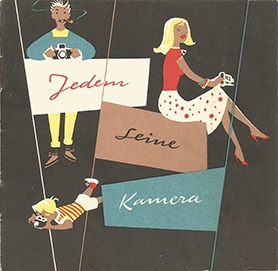
[57_Jedem_as.jpg]
|
|
German-language booklet.
Approximate dimensions: 135mm ×131 mm
12 pages
Over a period of several years, the Dresden
camera manufacturer KW, which had created
the Praktisix, published each year a booklet
covering their wide range of cameras, with
the title “Jedem Seine Kamera”.
Click on the image here to see the front
of the booklet full size.
|
|

[57_Jedem_10s.jpg] |
|
Page 10 of this
booklet introduces the new
Praktisix.
We note that it states that there
are lenses from 65mm to 400mm, so it
had obviously become clear that the
60mm lens announced, in advance of
its manufacture, in the earlier
brochure, had turned out to be not
quite that wide.
We note also a reference to a
pentaprism, although this also
appears to have been at the
preparation stage.
Click on the image here to see page
10 of the booklet full size.
|
|
| 1958
|
|
|
|
|
|
|
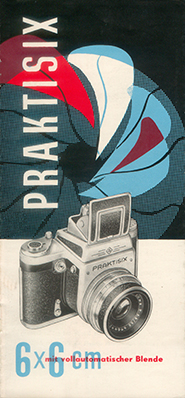
[58_Praksix_as.jpg]
|
|
German-language
leaflet
Approximate dimensions: 98mm ×
210mm
Approximately 12 pages, including two
cut-out flaps that fold out in the style
that was popular with East German publicity
literature of the period.
Click on the image here to see the front of
the leaflet full size.
The phrase on the front is “6×6 cm mit
vollautomatischer Blende”, which means “6×6
cm with Fully-Automatic Diaphragm”,
something that was a world first for Medium
Format cameras (but matched in the same year
with the West German Zeiss lenses for the
Hasselblad 500C).
As well as presenting the features of the
camera, the leaflet also shows a photograph
of a body with a plain prism mounted on it.
The lenses listed are the 80mm Tessar, 65mm
Flektogon, 80mm f/3.5 Meyer Primotar, 120mm
Biometar and 300mm f/4.5 Meyer Telemegor.
The lens in the photographs bears the name
“Jena T”, so the photograph was clearly
intended to be usable in countries where the
GDR could not use the name “Carl Zeiss” or
Carl Zeiss brand names such as
“Tessar”. However, the German version
of this leaflet was clearly targeted at East
Germany, since in the text repeatedly uses
the name “Zeiss” and brand names such as
“Tessar” and “Biometar”. This is
confirmed by the fact that one of the copies
of this leaflet that I have bears a rubber
stamp from Photohays W. LUX in Erfurt, which
is in what was at the time the Soviet
occupied zone of Germany.
|
| 1959 |
|
|
|
|
|
|
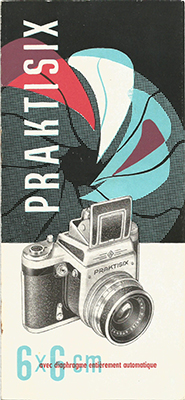
[59_Fr_as.jpg] |
|
French-language
leaflet
Approximate dimensions: 98mm × 210mm
This is a French-language version of the
above 1958 leaflet and it is dated 1959.
Approximately 12 pages, including two
cut-out flaps that fold out in the style
that was popular with East German publicity
literature of the period.
Click on the image here to see the front of
the leaflet full size.
The phrase on the front of the leaflet is
“6×6 cm avec diaphragme entièrement
automatique”, an accurate translation of the
phrase on the original German brochure.
In this version of the leaflet, the name
“Zeiss” is not used; lenses from Carl Zeiss
Jena are merely named as “Iéna”, the
standard French spelling of the town.
The names “Tessar” and “Biometar” are also
not used, being replaced by “T” and
“Bm”. In fact, West German Zeiss never
used the name “Biometar”, but it is assumed
that they had registered it as a potential
lens name. The Carl Zeiss Jena name
for its wide-angle lenses, “Flektogon”, was
a new name and so could be used anywhere in
the world, and does indeed appear in this
French leaflet. (The name chosen by
West German Zeiss for their wide-angle
lenses was “Distagon”, to indicate the
increased distance of the lens from the film
plane, in order to allow space for the SLR
mirror.)
|
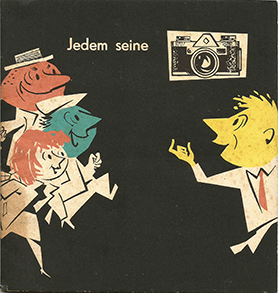
[59_Jedem_as.jpg]
|
|
German-language booklet.
Approximate dimensions: 135mm ×141 mm
24 pages
Here we show the 1959 edition of KW’s
“Jedem Seine Kamera”, the first in which the
KW logo is replaced (on the back cover, not
shown) by the blue Pentacon
tower logo.
Click on the image here to see the front of
the booklet full size.
This is the first edition of the booklet
that I have seen (and I have the 1957 and
1958 issues) where a list of the lenses
available for the Praktisix is given.
|
|
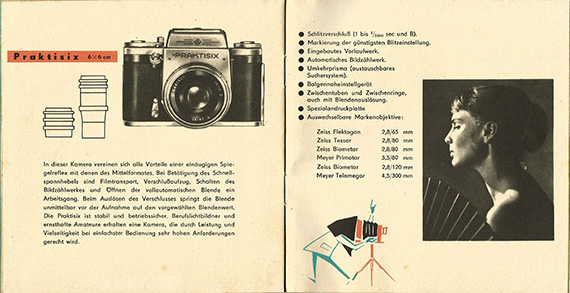
[59_Jedem_18-19s.jpg]
|
|
From the use of
the name “Zeiss” and brand names
such as “Tessar” and “Biometar”, we
deduce that this booklet was
designed for distribution in East
Germany and possibly some other
countries where these names could be
used.
We note that already in 1959 a
significant range of lenses is
listed: from Zeiss Jena, the 65mm
Flektogon, the 80mm Tessar and the
80mm and 120 mm Biometars; from
Meyer the 80mm f/3.5 Primotar and
the 300mm f/4.5 Telemegor.
Click on the image here to see pages
18 and 19 full size.
|
|
|
|
|
|
|
|
|
1961
|
|
|
|
|
|
|
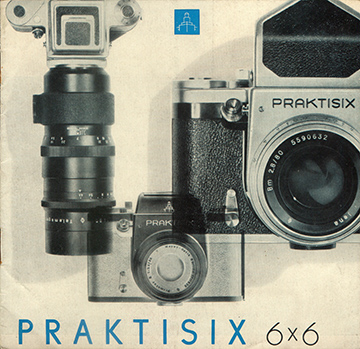
[61_Praksix_a_2s.jpg]
|
|
German-language
brochure
Approximate dimensions: 198mm × 194mm
Approximately twelve pages, although some
pages are half-width and others have
fold-out flaps in the style that was popular
for East German photographic brochures at
the time.
Click on the image here to see the front of
the brochure full size.
With this leaflet, Pentacon’s publicity
department used the size and the nearly
square format that they were to use for many
years for most Praktisix and Pentacon Six
camera publicity – though they soon
abandoned the use of fold-out flaps.
A wider range of lenses is listed
than in the 1958/1959 leaflet above, with
the addition of the 50mm Flektogon and the
1000mm mirror lens, however, both of these
lenses and the 180mm “S” are marked “in
preparation”.
The leaflet avoids the use of the names
“Zeiss” and “Biometar”, a clear indication
that it was intended to be distributed in
West Germany. The photo credits show
that one prominently-placed photograph was
by a West German photographer, while other
photos were from photographers in communist
countries (East Germany, Hungary and
Czechoslovakia). |
|

[61_Prak6_a_bs.jpg]
|
|
English-language
leaflet
Approximate dimensions: 98mm × 210mm
Single sheet
folded in two places to create
six narrow pages,
however, here I have partially
unfolded it in order to show
both the front and the back of
the leaflet.
Click on the image here to
see the leaflet full size.
This version was printed in
English and is clearly for the USA
market, since it avoids using the
name “Zeiss” and the lens names
claimed by West German Zeiss.
These names could have been used for
printed materials destined to be
used in the U.K.
This surmise is confirmed by
the presence on the front of a
rubber stamp from a U.S. camera
store in Boston, Massachusetts – and
on the back of another stamp, this
one probably added by or at the
insistence of the U.S.A. Customs
authorities. It states,
“Printed in East Germany
U. S. S. R. OCCUPIED”.
The lens range listed is
the same as in the other 1961
leaflet, reproduced to the left
here, although the 180mm “S” lens is
no longer marked “in preparation”.
|
|
| 1963 |
|
|
|
|
|
|
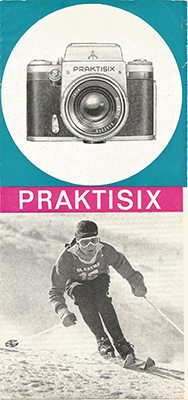
[63_Frs.jpg] |
|
French-language leaflet
Approximate dimensions: 100mm × 210mm.
Single sheet folded in two places
to create six pages.
Click on the image here to see the front
of the leaflet full size.
The same lenses are listed as in the above
1961 leaflets, but now none of them are
marked “in preparation”.
In addition, the rarely seen East German
500mm f/4 mirror lens is listed – the only
time that I recall seeing it specified for
the Praktisix. It is usually found
with mounts for 35mm cameras, principally
the Praktina and the Praktica. In
fact, the 1960 Carl Zeiss Jena leaflet on it
describes it as being “FÜR
KLEINBILDREFLEXKAMERAS”, i.e., “FOR 35MM
REFLEX CAMERAS”.
|
|
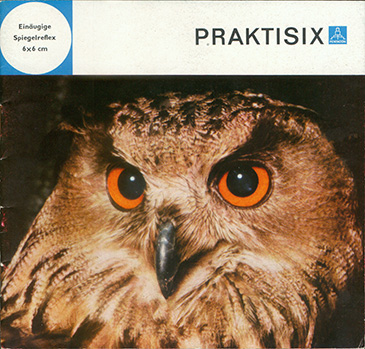
[63_Gers.jpg]
|
|
Substantial
German-language brochure in the size
and format used for many years for
these cameras.
Approximate dimensions: 198mm ×
190mm
28 pages, printed on heavy,
good-quality paper.
Click on the image here to
see the front of the brochure full
size.
Highly illustrated, with a
report showing a West German
university professor using a
Praktisix on a zoological expedition
in Africa, and another on an East
German scientist using one for
close-up photography in his
laboratory.
The 500mm mirror lens is no
longer listed, and so it seems that
it was included in the French
leaflet on the left in error.
|
|
| 1964 |
|
|
|
|
|
|
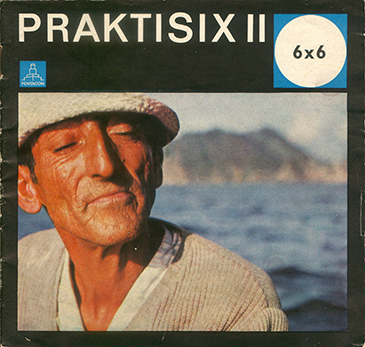
[64_Praksix2s.jpg] |
|
English-language
brochure largely based on the German “owl”
brochure produced the year before.
Approximate dimensions: 198mm × 190mm
24 pages, printed on good-quality paper.
Click on the image here to see the
advertisement full size.
To be noted is that this brochure introduces
the PRAKTISIX II.
Lenses listed are both Flektogons (50mm and
65mm), both Biometars ( 80mm and
120mm – named “Bm”), just the one Sonnar (180mm
– named “S”), the 100mm mirror
lens, and two lenses from Meyer Görlitz (the
80mm f/3.5 Primotar and the 300mm f/4.5
Telemegor).
The West German zoologist and the East
German scientist are featured again, along
with a Czechoslovak press photographer,
along with studio fashion and advertising
photography, sports photography and
macrophotography. |
|
|
|
|
|
|
|

[64_Praktisix_II_01s.jpg]
|
|
German-language
leaflet
Approximate dimensions:100mm × 205mm
Single sheet folded in three places to
create 8 pages
Click on the image to
see the front and back of the leaflet full
size.
In order to save space and to
show more of this leaflet, I have unfolded
it and show two “pages” in each image.
In this first image we
see the front cover of the leaflet (to the
right) and the back cover (to the
left). The back cover has been
over-printed with details of a large photo
store in Düsseldorf, West Germany.
Between this image and the
next three I show the whole of the leaflet.
|
|

[64_Praktisix_II_02s.jpg]
|
|
The pages of this leaflet
are not numbered, but I will show
them in the order in which they were
probably intended to be read.
This page (or
double-page spread) introduces the
camera and points out some of the
improvements that were introduced
with the Praktisix II.
Thus it
describes the camera as “the
essential helper for uncounted
scientists, researchers, photo
journalists and demanding amateurs.”
Attention is
drawn to the fact that with the
Praktisix II the shutter speed dial
clicks into each speed setting,
something that was absent from the
original Praktisix. It makes
the point that this guarantees that
the exact speed chosen is set, which
increases the camera’s readiness for
use. Also when light levels
are low, secure speed setting is
possible.
Click on the image to see these
pages full size.
|
|
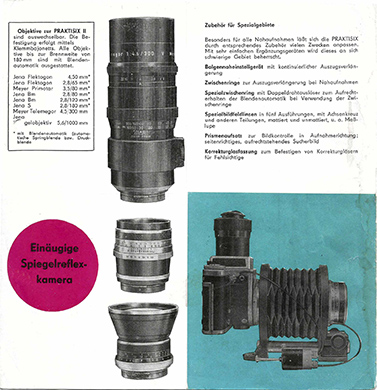
[64_Praktisix_II_03s.jpg]
|
|
The left-hand
side of this spread lists the lenses that
are available for the Praktisix II. We
note that the name “Zeiss” is missing from
this brochure, an indication that it was
intended to distribute this leaflet in West
Germany.
The brochure does use the name
“Flektogon”, as this had not been used by
West German Zeiss (which used the name
“Distagon” for its wide-angle lenses).
However, the name “Sonnar” is not used, as
it had been used by Zeiss since before World
War II and was still used by West German
Zeiss. So the leaflet uses the
designation “S”. It also does not use
the name “Biometar”, even though that name
was not used by West German Zeiss.
Instead, the leaflet has the abbreviation
“Bm”.
The 1000mm Mirror lens is again
included in the list of available lenses.
We note that aperture automation is
only available for lenses between 50mm and
180mm, as the (automatic) 300mm Sonnar had
not yet been introduced. The 500mm
Meyer (manual) lens was also not yet
available.
The right-hand side describes
bellows, close-up tubes, special focussing
screens, the pentaprism and the holder for
corrective viewfinder lenses.
Click on the image to
see these pages full size. |
|
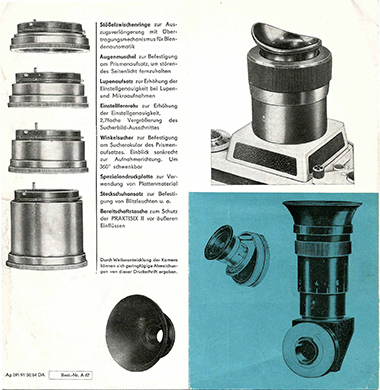
[64_Praktisix_II_04s.jpg]
|
|
On this double-page spread
we can see the first version of the
automatic extension tubes as well as
various aids to viewing the
focussing screen, the magnifier
head, the angle finder, the
focussing telescope and the eye cup.
The special pressure
plate to be used with photographic
glass plates is also described, as
well as the accessory holder and the
ever-ready case.
Click on the
image to see these pages full
size.
|
|
| 1965 |
|
|
|
|
|
|
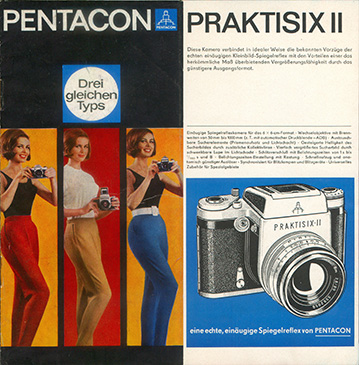
[65_3gleichens.jpg]
|
|
German-language
leaflet.
Approximate dimensions: 101mm × 200mm
Two sheets folded in
two places to create twelve narrow pages,
however, here I have partially unfolded
one page in order to show the
information on the Praktisix II.
Click on the image here to
see the leaflet full size.
The title, “Drei gleichen Typs”, means
“Three of a kind”. The other two
cameras featured are Pentacon’s leading 35mm
SLRs of the time, the Praktica nova and the
Praktica mat. In such a small leaflet,
it is impossible to list all components and
characteristics, but a good summary of the
main points is given in the text and the
photographs.
|
| 1966 |
|
|
|
|
|
|
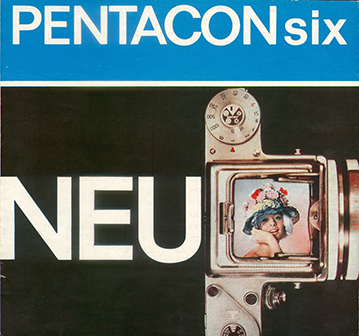
[66_Pent6s.jpg]
|
|
German-language
leaflet introducing the new version of the
camera and the new name: “PENTACON six”
Approximate dimensions: 200mm × 189mm
This is a single sheet folded in two places
to create six wide pages.
Click on the image here to see the leaflet
full size.
The title, “NEU”, means “NEW”.
The possibility of taking 24 pictures with
220 film is emphasised, and illustrated with
23 pictures plus a large “6×6”. The
lenses are not listed, but the brochure
states that lenses up to 300mm have fully
automatic diaphragm, which means that the
300mm Zeiss “Sonnar” must now be available.
|
| 1967 |
|
|
|
|
|
|
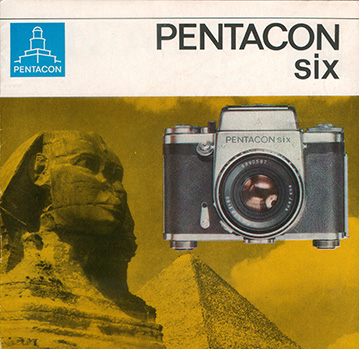
[67_Pent6s.jpg]
|
|
Brochure seen
in English-language and German-language
versions.
Approximate dimensions: 200mm ×
191mm
12 pages, printed on good-quality paper.
Click on the image here to see the brochure
full size.
Comprehensive listing of lenses and
accessories, which are also illustrated with
photographs. We note that the 300mm
f/4.5 Meyer Telemegor has been replaced with
the new 300mm f/4 lens, here still called
“Telemegor”, apparently in error, as this
was (subsequently?) known as the
“Orestegor”. The new 500mm f/5.6 Meyer
lens is correctly called “Orestegor”.
There seems to have been some confusion in
the publicity department, as the
English-language version repeatedly uses the
word “Zeiss” but is shy of saying “Sonnar”
or “Biometar”, so the two Biometars (80mm
and 120mm) are called “Bm” and the two
Sonnars (180mm and 300mm) are called “S”.
In contrast, the German-language version
happily uses “Biometar”, “Sonnar” and
“Zeiss” repeatedly, but strangely calls the
two Flektogons (50mm and 65mm) “aus Jena”.
The possibility of 24 exposures on one film
is emphasised, and illustrations suggest the
camera’s suitability for concerts, wildlife,
macro, fashion and sports photography.
|
| 1968 |
|
|
|
|
|
|
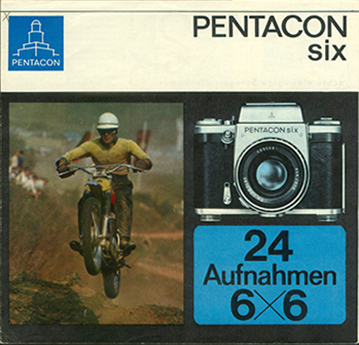
[68_Pent6_as.jpg]
|
|
German-language leaflet
Approximate dimensions: 200mm ×
190mm
Four pages, printed on good-quality
light-weight paper
Click on the image here to see the front
cover of the leaflet full size.
The front cover emphasises the format and
the 24-exposure capabaility: “24 Aufnahmen
6×6” means “24 6×6 exposures”.
The absence of the name “Zeiss” indicates
that the leaflet was intended to be usable
in West Germany.
The Meyer 80mm f/3.5 Primotar is no longer
listed, and the 300mm f/4 Meyer lens is now
correctly called “Orestegor”.
|
|
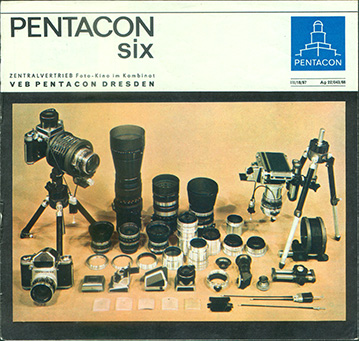
[68_Pent6_bs.jpg]
|
|
Here I have decided to
reproduce the back cover of the leaflet
shown on the left here, as it includes most
of the lenses and accessories available at
that time – and for many years thereafter.
Click on the image here to see the back
cover of the leaflet full size.
We note that this was when the Zeiss lenses
were finished in the “zebra” style, and that
only the 1000mm mirror lens and the 300mm
Meyer Orestegor are missing from the
photograph. The all-black lens is the
500mm Meyer Orestegor. Meyer never
adopted the “zebra” style.
The metering prism is of course also not
there, as it was not introduced until later
that year, but there are two examples of the
Pentacon tripod, revealing some of its
flexibility.
|
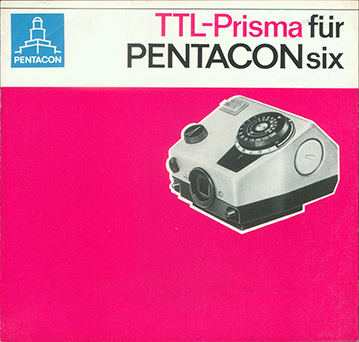
[68_TTL_as.jpg]
|
|
German-language leaflet
Approximate dimensions: 200mm ×
190mm
Four pages, printed on
good-quality light-weight paper
Click on the image here to see the front
cover of the leaflet full size.
This is, strictly-speaking, an
“accessory”, but I include it here since I
view a metering pentaprism as such an
integral part of the Pentacon Six. It
fundamentally changed the way it was
possible to use the camera, and led to
the camera eventually being renamed
“Pentacon Six TL”.
|
|
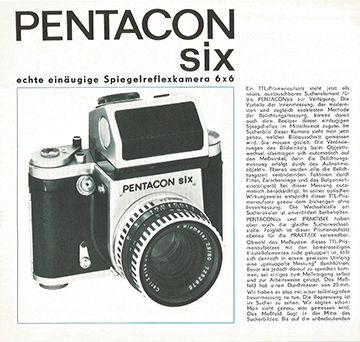
[68_TTL_2s.jpg]
|
|
Page two of the metering
prism leaflet shows the front of the TTL
prism, mounted on the camera.
Click on the image here to see page 2 of the
leaflet full size.
The leaflet explains how the prism operates.
|
We see that
the manufacturers had decided to adopt the
standard English-language abbreviation for
metering pentaprisms. “TTL” means
“through the lens”. This phrase, used
internationally from the late 1960s,
distinguished from those cameras that did
have built-in light metering, but not
through the lens. Since the 1936 35mm
rangefinder Contax, also designed and built
in Dresden, there had been cameras with a
built-in meter that read through a window
somewhere on the front of the camera, but
not through the lens.
|
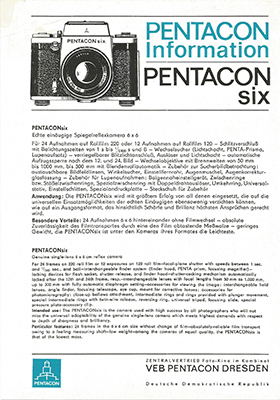
[68_flyer_as.jpg]
|
|
Multi-language
flyer sheet
Approximate dimensions: 150mm × 216mm
Single sheet
Click on the image here to see the front of
the sheet full size.
This is not in the style of Pentacon’s usual
publicity literature, and was perhaps
prepared for international commercial
visitors at a trade fair, perhaps the Leizig
Fair, which occurred every spring and
autumn. The description on the front
of the flyer is in German and English and on
the back it is in French, Spanish and
Russian. The quality of the English
translation is quite poor and not up to the
standard usually seen in Pentacon literature
(itself far from faultless or
natural-sounding, at times!). This
could point to it having been prepared in a
hurry without having been checked by the
usual staff at the publicity department of
Pentacon or of the official Government
export agency.
|
| 1969 |
|
|
|
|
|
|
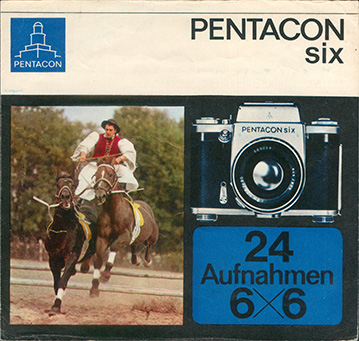
[69_Pent6_as.jpg]
|
|
German-language
leaflet
Approximate dimensions: 200mm ×
190mm
Four pages, printed on
good-quality light-weight paper
Click on the image here to see the front
cover of the leaflet full size.
We note that even though the metering prism
was released the previous year, and an
inside page of the leaflet shows the camera
with a metering prism, the camera name has
not yet been changed to “Pentacon Six TL”.
The 65mm Flektogon lens is still listed.
This leaflet was clearly designed for use in
markets where the name “Zeiss” and other
West German Zeiss names could not be used.
The back of the leaflet has a
black-and-white copy of the colour
photograph on the back of the 1968 leaflet,
above.
|
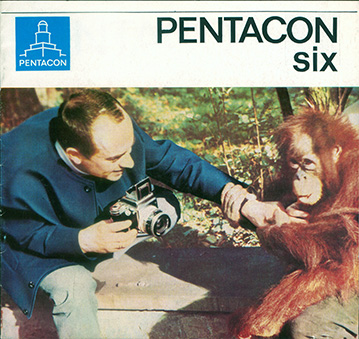
[69_Pent6_2_as.jpg]
|
|
Brochure seen in
German-language and Russian-language
versions.
Approximate dimensions: 200mm ×
188mm
12 pages, printed on good-quality paper.
Click on the image here to see the front
cover of the brochure full size.
The 65mm Flektogon is no longer
listed. It would appear that the final
production-run of this lens was 1,000 units,
completed on 10th February 1969, according
to Helmut Thiele in “Fabrikationsbuch
Photooptik II Carl Zeiss Jena”, 3rd edition,
2005, page 190.
|
|
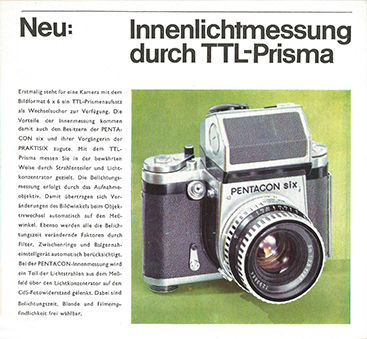
[69_Pent6_2p4s.jpg]
|
|
Pages 4 and 5 of the
brochure shown on the left features the new
TTL metering pentaprism. Here I
reproduce page 4.
The page title, “Neu: Innenlichtmessung dur
TTL-Prisma”, means “New: Internal light
metering through TTL Prism”.
Click on the image here to see page 4 of the
German-language version full size.
|
| 1970
|
|
|
|
|
|
|
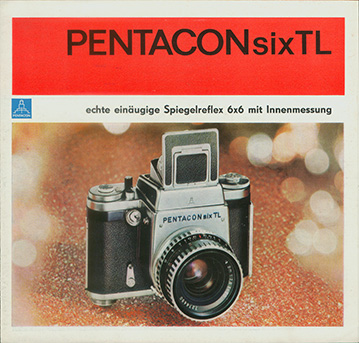
[70p6TL_as.jpg]
|
|
German-language leaflet
Approximate dimensions: 200mm ×
190mm
Four pages, printed on
good-quality light-weight paper
Click on the image here to see the front
cover of the leaflet full size.
At last we see the new camera name on the
front of publicity from the manufacturer.
|
|
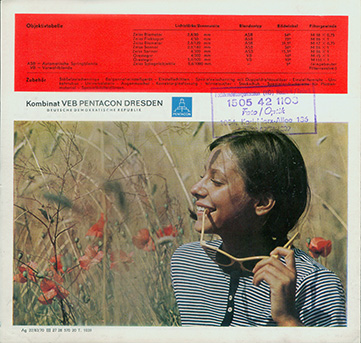
[70p6TL_bs.jpg]
|
|
The back of this leaflet,
reproduced here, confirms that it was
designed for use in East Germany or other
countries where the name “Zeiss” and lens
names such as “Sonnar” and “Biometar”could
be used.
There is another clue: the rubber stamp
containing the shop details. We see
that it is a shop run by the East German
communist government, using the Government
abbreviation “HO”, which stands for the
official East German name
“Handelsorganisation”, perhaps best
translated into English as “Trading
Organisation”. Created in the
Soviet-occupied zone of Germany in 1948,
“HO” collapsed shortly after the collapse of
the East German communist state. (See
Wikipedia, at the time of writing here: https://en.wikipedia.org/wiki/Handelsorganisation)
(Another clue is the name of the street
where the shop was located:
“Karl-Marx-Allee”! This would appear
to be the Boulevard in East Berlin that
reportedly had been named “Stalinallee”
between 1949 and 1961.)
Click on the image here to see the back
cover of the leaflet full size.
|
| 1972 |
|
|
|
|
|
|
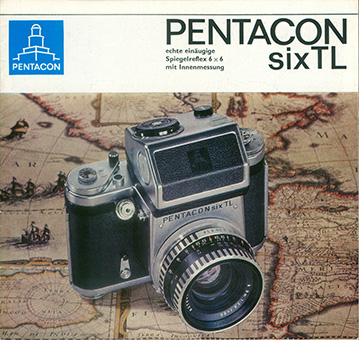
[72_Pent6TL_as.jpg]
|
|
German-language
brochure
Approximate dimensions: 200mm ×
190mm
12 pages, printed on good-quality
light-weight paper
Click on the image here to see the
front cover of the brochure full size.
The title, “echte einäugige Spiegelreflex 6
× 6 mit Innenmessung”, means “Genuine 6 × 6
Single Lens Reflex with Internal Metering”.
Again, the use of disputed names such as
“Zeiss” indicates that the target markets
for this brochure were East Germany itself
and possibly other Communist bloc countries
where those trading with the GDR might know
some German.
Were the East Germans beginning to give up
on spending money producing publicity
materials for West Germany, perhaps leaving
it to the distributor there to produce his
own publicity? Perhaps.
|
| 1973 |
|
|
|
|
|
|
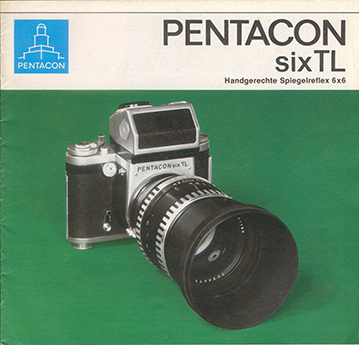
[73_Pent6TL_as.jpg]
|
|
German-language brochure
Approximate dimensions: 200mm ×
190mm
12 pages, printed on good-quality
light-weight paper
Click on the image here to see the
front cover of the brochure full size.
The title, “Handgerechte
Spiegelreflex 6 × 6”, means approximately
“Hand-holdable 6 × 6 Single Lens Reflex”.
The middle-page spread illustrates and
describes the various focussing screens that
were available for the Pentacon Six TL and
the next page includes in the photo of the
lenses available the infrequently-seen
1000mm mirror lens, as well as both of the
Meyer lenses.
|
|
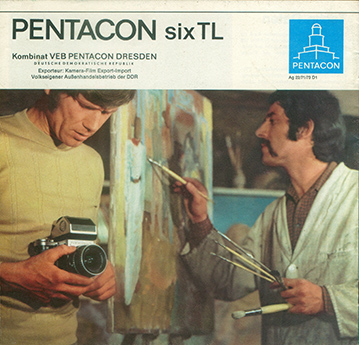
[73_Pent6TL_bs.jpg]
|
|
Here we show the back of
the same leaflet.
Click on the image here to
see the back cover of the brochure full
size.
The unspoken message here
seems to be, “Both the ‘Old
Masters’ and the ‘New Masters’ produce
beautiful pictures, each with the tools of
his trade (but the ‘Old Master’ is in the
background and the ‘New Master’ is in the
foreground, symbolizing the progress of the
world and technology under the communist
system!)” May I be forgiven if I am
reading too much into this carefully-staged
image. |
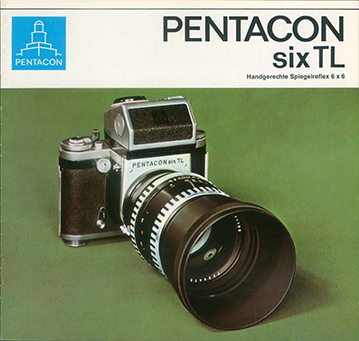
[73_Pent6TL_2_as.jpg]
|
|
German-language brochure.
Approximate dimensions: 200mm × 190mm
8 pages, printed on good-quality glossy
paper.
Click on the image here to
see the front cover of the brochure full
size.
At first glance, this
brochure, which was also produced in 1973,
looks very similar to the previous one, but
there are differences. Changes
of layout have been required in order to
squeeze largely the same text and most of
the same illustrations into less pages, with
only a small reduction in font size.
|
|
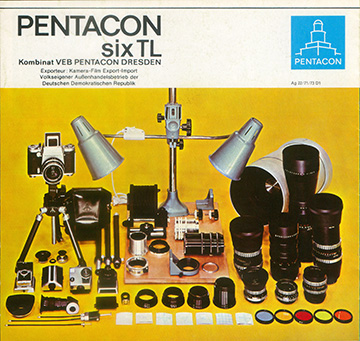
[73_Pent6TL_2_bs.jpg]
|
|
The back of this brochure
has a newly-produced photograph of the
Pentacon Six system, with metering prism and
all the East German lenses, plus a range of
colour filters for the standard lens.
Click on the image here to
see the back cover of the brochure full
size.
We definitely see the
signs of an active publicity department,
constantly seeking to improve the literature
that they produce (and no doubt also, to
control costs!)
We note that the exporter details state:
“Exporteur: Kamera-Film Export-Import
Volkseigener Außenhandelsbetrieb der
Deutschen Demokratischen Republik”, which
means “Exporter: Camera-Film Export-Import
Peoples Own Foreign Trade Organisation of
the German Democratic Republic”.
|
| 1976 |
|
|
|
|
|
|
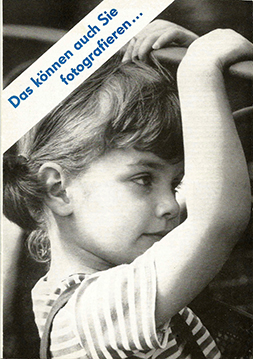
[76_recruiting_1_s.jpg] |
|
German-language
brochure
Approximate dimensions: 140mm ×
200mm
This was cut exceptionally crooked
at top and bottom. I have
tried to eliminate this error as
much as possibe. Thereby a
little of the height has been lost.
Single sheet folded in two places,
to create six pages.
Given the unusual content and target
audience of this brochure, I have
decided to reproduce it here in
full, with a trnaslation of the
original German text.
The title on the front cover says:
“You too can photograph that …”
Click on this image to see
it larger
|
|
|
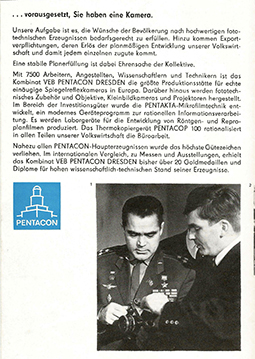
[76_recruiting_2_s.jpg]
Click on this image to see
it larger
[The caption for
the photo is on the next page.]
|
|
Translation:
“… provided that you have a camera.
Our mission is to fulfil the
wishes of the population for high
quality photo-technical products in
accordance with their needs.
There are in addition export
obligations, the revenue from which
benefits the development of our
People’s Economy in accordance with
the Plan and thereby every
individual derives benefit.
So a stable attainment
of the production targets of the
Plan is a matter of honour for the
Collective.
With 7500 workers,
employees, scientists and
technicians, the State Combine
Peoples’ Own Business PENTACON
DRESDEN is the largest manufacturing
facility for genuine Single Lens
Reflex cameras in Europe.
Moreover, photo-technical
accessories and lenses, 35mm cameras
and projectors are
manufactured. In the Capital
Goods area of specialisation, the
PENTAKTA Microfilm technology was
developed, a modern programme of
equipment for the efficient
processing of information.
Various types of laboratory
equipment for the development of
X-ray and Reproduction sheet film
are produced. The thermal
copying machine PENTACOP 100
streamlines office work in all parts
of our People’s Economy.
Virtually all of the
principal products of PENTACON are
awarded the highest Quality
Mark. In international
comparisons, in Trade Fairs and
Exhibitions, the People’s Own
Business PENTACON DRESDEN State
Combine has so far received more
than 20 Gold Medals and Diplomas for
the high scientific and technical
standard of the items that it
produces.”
|
|
Comment:
While we recognise that until about 1980 the
quality of cameras produced in communist
East Germany was on a par with world
standards at that time, we would point out
that the main Trade Fair in which their
products were displayed was the Leipziger
Messe, the twice per year Trade Fair in the
city that from 1949 became part of the
so-called “German Democratic Republic”, the
thoroughly undemocratic
communist dictatorship that followed orders
from the Soviet Union. Unsurprisingly,
that Fair awarded prizes to products
manufactured in East Germany.
The other principal Trade Fairs and
Exhibitions in which East German products
were displayed were mostly in other
Communist countries. It is also a fact
that manufacturing standards in the GDR were
way above the standards in the USSR, where
many non-functioning items left factories,
where there seems to have been no quality
control, merely a determination to meet the
production targets set by the successive
“Five Year Plans” dictated by the
centralised bureaucracy controlled by the
Communist Party. Thus, GDR products
often were indeed the best, compared with
the other products in such Fairs, which were
principally from other Communist countries.
As regards the “thermal copying machine
PENTACOP 100”, when the East German
communist dictatorship collapsed after the
breaching of the Berlin Wall in November
1989, photocopying technology in Communist
countries was decades behind technical
developments in the free world, both East
and West. The fact was that the
Communist dictatorships had no desire to
improve photocopying technology or the
availability of photocopiers. Under
régimes that were paranoid about the
reproduction and possible dissemination of
information not controlled by the State,
photocopying was not available, even in
professional environments such as
hospitals. In 1978 one East German
doctor told me that if he wanted a copy of a
specialist article on heart surgery, he had
to copy it out by hand.
Christians in the Soviet Union had hymn
books hundreds of pages long, each one of
them copied out by hand. This report
is based on my own personal observation in
the former Soviet Union, shortly after the
collapse of the Communist system. This
was “Samizdat” in operation, the clandestine
copying and distribution of literature
banned by the State in countries of the
Soviet bloc. In East Germany in 1981,
an active promoter of Communist Party
ideology told me that there was no ban on
printing Bibles and hymnbooks, merely “a
shortage of paper” and there was no ban on
buildings maintenance work for churches,
merely “a shortage of cement, bricks,
plaster and paint”. At times, such
shortages did exist, and the supplies that
were available were required to be used to
achieve the political objectives of the
Communist Party and the ruling élite. However,
the existence of books that were bound with
hundreds of pages of blank paper
demonstrates that a “shortage of paper”
was not the problem, but the State refusal
to grant permission to print such items.
These are illustrations of how the
political ideology of those in power was a
barrier to technological development in
the Communist bloc. In the 1980s,
Carl Zeiss Jena and Pentacon were obliged
by the government to focus their research
and development on the design and
production of surveillance cameras to be
used by the STASI, the State Secret
Police, for spying on the citizens of the
country. This virtually halted the
development of photography by Carl Zeiss
and Pentacon, and neither auto-focus
lenses nor zoom lenses were developed in
East Germany (although in the final years
of the decade some zoom lenses were
imported by Pentacon from the Far East and
re-branded as “Pentacon”). It is one
of the oddities of history that the new
surveillance equipment finally entered
production in 1989, a few months before
the requirement for it ceased with the
collapse of the authoritarian system.
|
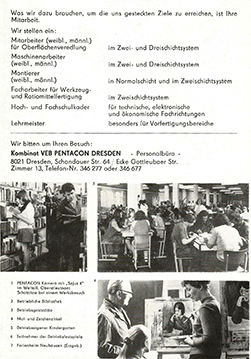
[76_recruiting_3_s.jpg]
Click on this image to see it
larger |
|
Translation:
“What we need for this, in order to
reach the Targets that have been set
us, is your collaboration.
We are
recruiting:
Employees (female, male) for the
finishing of surfaces – in the 2-
and 3-shift system
Machine operators (female, male) –
in the 2- and 3-shift system
Assembly workers (female, male) – in
the normal shift and 2-shift system
Craftsmen (skilled technicians) for
the production of tools and other
resources [Ratiomittel not found] –
in the 2-shift system
Cadres [“staff”] for High School and
Technical School – for technical,
electronic and economic specialist
fields
Instructors – especially for the
areas of parts manufacturing
We invite you
to visit:
People’s Own Business PENTACON
DRESDEN State Combine – Personnel
Office
8021 Dresden, Schandauer Strasse 64
/ Corner of Gottleubar Strasse
Room 13, Telephone number 346 277 or
346 677
1.
PENTACON camera with “Soyuz 4” in
Space, Lieutenant-Colonel Schatalov
during a visit to the factory
2. Works Library
3. Works
Restaurant
4. Painting and
Drawing Circle
5. Works own
Kindergarten
6. Participants in
the Works Games
7. Neuhausen
Holiday home (Erzgebirge, Saxony)” |
|
|
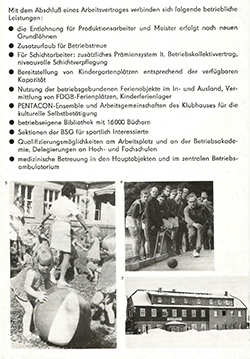
[76_recruiting_4_s.jpg]
Click on this image to see it
larger
|
|
Translation:
“The following benefits are an
integral part of the completion of a
contract of employment:
- the remuneration
for production workers and
skilled staff is in accordance
with the new Basic Wages
- Additional
holidays for loyal workers
- For shift
workers: additional rewards
system in [?] the Works
Collective Contract, high
quality shift catering
- Provision of
Kindergarten places in
accordance with the available
capacity
- Use of domestic
and overseas holiday
destinations linked to the
Works, provision of Holiday
places of the FDGB and
Children’s Holiday Camps [see
note below]
- PENTACON-Ensemble
and Clubhouse Working Groups for
cultural voluntary involvement
- Works Library
with 16,000 books
- Sections of the
BSG [Betriebssportsgruppe?] for
those with sporting interests
- Possibilities to
obtain qualifications in the
workplace and at the Works
Academy, or to be sent to High
Schools and Technical schools
- medical care in
the principal buildings and in
the central Works Medical
Centre”
“FDGB” is defined
below.
|
|
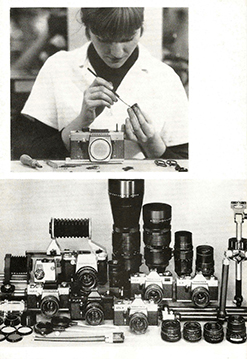
[76_recruiting_5_s.jpg]
Click on this image to see
it larger |
|
FDGB:
“The [so-called] “Free German Trade
Union Federation” (German: “Freier
Deutsche Gewerkschaftsbund” or
“FDGB”), was the sole national trade
union centre of the German
Democratic Republic (GDR or East
Germany) which existed from 1946 and
1990. As a mass organisation of the
GDR, nominally representing all
workers in the country, the FDGB was
a constituent member of the National
Front. The leaders of the FDGB were
also senior members of the ruling
Socialist Unity Party.”
https://en.wikipedia.org/wiki/Free_German_Trade_Union_Federation
Accessed on 2.4.22.
We note that the first captioned
picture in the leaflet features a
well-known Soviet astronaut and the
success of the USSR “Soyuz 4” space
programme, an apparently-obligatory
adulatory reference to the Soviet
Union. The model of the camera
that he is holding is not even
mentioned.
In the image
to the left we see the first version
of the Praktica VLC 35mm SLR being
assembled and in the picture below
it we see a range of Pentacon
cameras and Carl Zeiss and Pentacon
(Meyer-Optik Görlitz) lenses and
other accessories. A Pentacon
Six metering pentaprism is beside a
Pentacon Six TL and the other
cameras are a Praktica VLC 2, a PLC
2, an LTL 3, an L 2 and an LB
2. To the best of my
knowledge, the LB 2 was not imported
into the UK. It has a non-TTL
light meter, the window of which can
be seen at the right end of the
front plate, as viewed in the
photograph here. Both of the
bellows units for the 35mm cameras
can be seen, as well as the Pentacon
tripod, filters and a range of
lenses, including the 300mm and
500mm Pentacon lenses, which were
also available in the Pentacon Six
mount.
|
|
|

[76_recruiting_6_s.jpg]
Click on this image to see
it larger
|
|
Translation:
“Principal Manufacturing Locations
Further Locations
Publication with permission of the
Council of the City of Dresden, Work
Office”
This page presents a simplied street
plan showing the location of the
main Pentacon buildings in Dresden,
as well as the numbers of the tram
lines that pass by or near the
buildings. It is interesting
to note that it was not possible to
produce even this simple recruitment
leaflet without official permission
from the Communist city
authorities. It is clear that
not even the great “People’s
Own Business PENTACON DRESDEN
State Combine Personnel Office”
was trusted to publish anything
without approval from an external
body.
|
|
| 1977 |
|
|
|
|
|
|
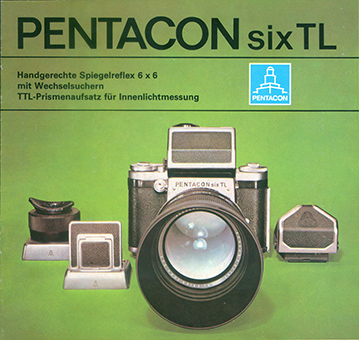
[77_Pent6TL_as.jpg]
|
|
German-language brochure.
Approximate dimensions: 200mm × 190mm
8 pages, printed on good-quality glossy
paper.
Click on the image here to see the front
cover of the brochure full size.
Largely based on the second 1973 brochure
shown above, but with all equipment
photographs re-shot to show the new
all-black style of the Zeiss lenses.
|
|

[77_Pent6TL_bs.jpg]
Click on the above image to see the back
cover of the brochure full size.
|
|
The back cover
of this brochure shows a re-design of the
system photograph. Here are the new
all-black-finish Zeiss lenses, although the
50mm Flektogon and the 120mm Biometar seem
to have rubberized grips that I have never
seen. Perhaps they were prototypes
that didn’t make it to serial
production. We observe that the 1000mm
mirror lens is not in the photograph,
perhaps because there were plans to produce
an all-black version, but these lenses had
not yet been produced.
We note that the exporter details now have a
new name, “Exporteur: HEIM-ELECTRIC
Export-Import Volkseigener
Außenhandelsbetrieb der Deutschen
Demoktratischen Republik”, which means
“Exporter: HEIM-ELECTRIC [DOMESTIC
ELECTRIC] Export-Import Peoples Own
Foreign Trade Organisation of the German
Democratic Republic”.
As well as being governed by five-year
plans, communist ideology and what would be
acceptable to their masters in the Soviet
Union, East German industry was plagued by
constant reorganisations and re-brandings,
probably reflecting the ebbs and flows of
power of competing groups in a country that
was riven by discord and the constant danger
of public denunciations and being declared
an “enemy of the People” or a “saboteur”or
an “enemy agent”, which resulted in
sentences that ranged from lengthy terms in
prison to the death penalty.
|
It would have been wonderful if Pentacon had
produced a special “Twentieth Anniversary”
brochure on the camera in 1977 – or even
a special “20th Anniversary Edition”
of the camera! – but apparently no-one
in Dresden thought of that.
Pity. And a missed marketing
opportunity.
|
| 1979 |
|
|
|
|
|
|
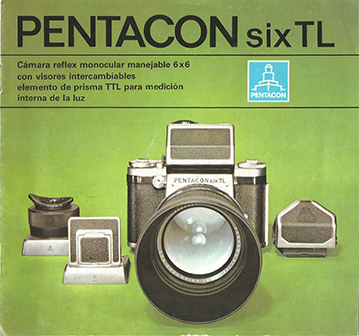
[79_Sp_1s.jpg]
|
|
Spanish-language brochure.
Approximate dimensions: 200mm × 190mm
8 pages, printed on good-quality glossy
paper.
Click on the image here to see the front
cover of the brochure full size.
This is a Spanish translation of the above
1977 brochure. The quality of the
Spanish is good, and this text may have been
produced by a native speaker.
This reminds us that communist East Germany
had strong links with the communist
government in Cuba, and when I was living in
East Germany in 1981, the only source
of “fresh” fruit such as oranges, even
in the summer, was apparently Cuba.
Unfortunately, most of the ones that reached
the shops even in major cities were small,
brown and generally inedible. East
Germany clearly needed to sell cameras and
other products to Cuba, to cover the cost of
its imports.
|
|
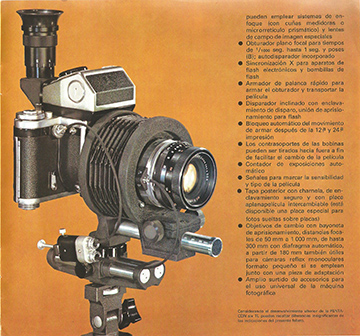
[79_Sp_7s.jpg]
|
|
Rather than repeating the
back cover of the brochure, which is the
same as in the original German version,
apart from the date and language references,
I am here showing page 7 of the brochure,
which shows a close-up set-up using the
bellows and the special aperture control
ring, along with the double cable release
and the angle finder on the metering prism,
all mounted on a Pentacon tripod.
The special aperture control ring (see here) is not
really necessary, since the front cable of
the double cable release can of course be
screwed directly into the bellows in order
to maintain lens aperture automation, and
the socket for this can be clearly seen on
the front of the bellows, just below the
socket on the special aperture control
ring. This ring can of course be used
to maintain aperture automation when the
lens is mounted in reverse on the
bellows. This can be seen here.
Click on the image here to see page 7 of
the brochure full size.
|
| 1983 |
|
|
|
|
|
|
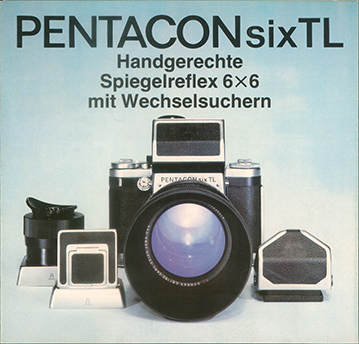
[83_Pent6TL_as.jpg]
|
|
German-language
leaflet
Approximate dimensions: 200mm × 190mm
Single sheet folded in two places to
create six pages
Printed on good-quality glossy paper.
Click on the image here to see the front
cover of the leaflet full size.
References to “Zeiss” and to lens names used
by West German Zeiss show that this leaflet
was not intended to be used in West
Germany. By now, most sales of the
Pentacon Six TL were to other “Ost Bloc”
(communist) countries.
We can also clearly see that the Sonnar on
the front page is labelled “MC”.
|
|
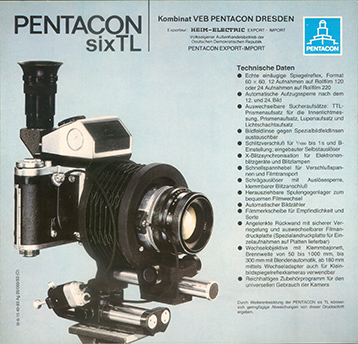
[83_Pent6TL_bs.jpg] |
|
The back cover of this
leaflet.
Click on the image here to see the back
cover of the leaflet full size.
The publicity department at Pentacon has
clearly re-shot the image used in their 1979
brochure, above – all the way down to
including the unnecessary special aperture
control ring! It is clear that the
people who set up and took these shots
didn’t actually personally do any macro work
with the Pentacon Six! (But we have
seen exactly the same sort of problem in
publicity brochures for the West German
Exakta 66 of 1984-2000!)
|
| 1984 |
|
|
|
|
|
|
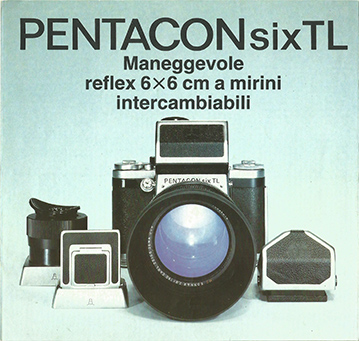
[84_It_1s.jpg]
|
|
Italian-language leaflet
Approximate dimensions: 200mm
× 190mm
Single sheet folded in two places to
create six pages
Printed on good-quality glossy paper.
Click on the image here to see the front
cover of the leaflet full size.
This is, as far as I can judge, a
translation of the 1983 German leaflet
above.
This reminds us that the Pentacon Six was
very popular in Italy, and the Italian
importers even added a special “Pentacon
Italia” sticker to the cameras that they
distributed. (See here.)
|
|
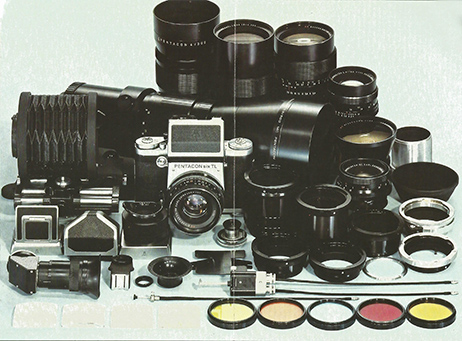
[84_It_3-4s.jpg]
|
|
Rather than
reproducing the back of the leaflet,
which is the same as the original
German version, apart from the date
and language references, I am here
showing the photo spread over pages
3 and 4 of the leaflet, which is a
new shot of the Pentacon Six TL
outfit (complete, apart from the
1000mm mirror lens).
Click on the image here to see the
photograph full size.
I note that the text of this Italian
leaflet carefully avoids using the
name “Zeiss” or other West German
Zeiss lens names. However, the
sharp-eyed reader will be able to
see the name “Zeiss” and the lens
names “Sonnar” and “Biometar” in the
photographs on the cover and on
these two pages.
|
|
| 1985 |
|
|
|
|
|
|
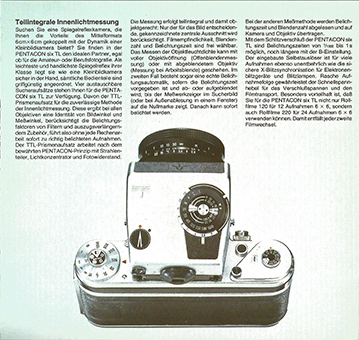
[85_P6p2s.jpg]
|
|
German-language
leaflet
Approximate dimensions: 200mm × 190mm
Single sheet folded in two places to
create six pages
Printed on good-quality glossy paper.
This is a reprint of the 1983 German
leaflet shown above. The front cover
is the same as in the original version, so
we have chosen to show page 2 here.
Click on the image here to see page 2 of the
leaflet full size.
|
|

[85_P6p5s.jpg]
|
|
Again, the back of the
leaflet is unchanged apart from the date, so
here we reproduce page 5.
Nowhere do manufacturers guarantee that the
photographs in their publicity brochures
were actually taken with the cameras
featured. However, for about 30 years
the Praktisix/Pentacon Six had been the only
Medium Format camera manufactured in East
Germany, so there is a good probability that
this picture was indeed taken with a
Pentacon Six.
Click on the image here to see page 5 full
size.
|
| 1988 |
|
|
|
|
|
|

[88_Pent6TL_as.jpg]
|
|
German-language
leaflet
Approximate dimensions: 200mm × 285mm
Single sheet folded once to create
four pages
Printed on good-quality glossy paper.
Click on the image here to see the front
cover of the leaflet full size.
Here, the publicity department has abandoned
the tradition of more than 25 years to
produce a totally new brochure in a totally
new shape.
It is good to see that they are still
promoting the Pentacon Six TL system, twenty
years after it reached its definitive form
and name.
The use in the leaflet of names such as
“Zeiss”, “Sonnar” and “Biometar” shows that
they do not intend to use this leaflet in
West Germany.
|
|
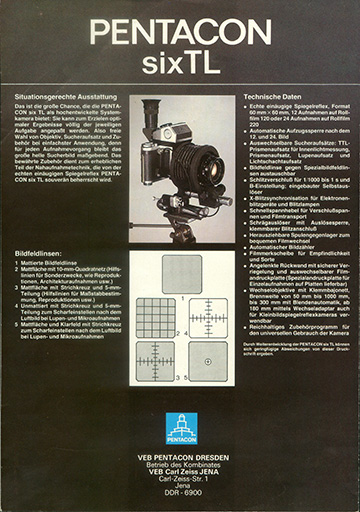
[88_Pent6TL_bs.jpg]
|
|
The back cover of this
leaflet.
The East Germans have cleverly named the
street where the headquarters of the
organisation are based “Carl-Zeiss-Str.”
(“Carl Zeiss Street”), which enables them to
insist on it being used even in
correspondence from abroad.
A year later, the citizens of East Germany
rose up and, after weeks of peaceful
protest, breached the Berlin Wall and then
started tearing it down. Within
another year, “The First Farmer and Worker
State on German Soil” was dead, to be
followed soon after by the collapse of most
of the markets where Pentacon and Carl Zeiss
sold their products.
It was the end of the line for the Pentacon
Six, in its East German form.
Click on the image here to see the back
of the leaflet full size.
|
|



















































